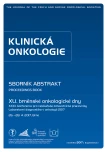Use of Porous Hydrogel as a 3D Scaffold for the Growth of Leukemic B Lymphocytes
Authors:
R. Studená 1,2; D. Horák 3; J. Baloun 1; Z. Plichta 3; Š. Pospíšilová 1,2
Authors‘ workplace:
Centrum molekulární medicíny, CEITEC – Středoevropský technologický institut, MU, Brno
1; Centrum molekulární biologie a genové terapie, Interní hematologická a onkologická klinika LF MU a FN Brno
2; Polymerní částice, Ústav makromolekulární chemie AV ČR, v. v. i., Praha
3
Published in:
Klin Onkol 2017; 30(Supplementum1): 184-186
Category:
Article
Overview
Background:
Primary human B cells chronic lymphocytic leukemia undergoes apoptosis, from which they can be rescued by contact with stromal cells or by the addition of specific soluble factor, when cultured in vitro. For research purposes of the behavior of CLL cells we created 3D in vitro model in which we simulated appropriate microenvironment for CLL cells to allow study the mechanism of survival of these cells in long-term cultivation.
Material and Methods:
Our aim was the scaffold structure to be geometrically similar to the 3D morphology of supporting bone marrow tissue in a trabecular bone; the 3D scaffold was also designed to conform to biocompatibility, sufficiently large surface area for cell attachment, high porosity for cell migration, proliferation and transport of nutrients. Another requirement was a partial transparency for inspection of cell model with optical techniques. We prepared 3D scaffolds from porous hydrogel poly (2-hydroxyethyl methacrylate) (pHEMA), poly (2-hydroxyethyl methacrylate-co-2-aminoethyl methacrylate) p (HEMA-co-AEMA) and p (HEMA-co-AEMA) modified with frequently used cell adhesion peptide Arg-Gly-Asp (RGD). All hydrogel scaffolds were manufactured in four pore diameters (125, 200, 300 and 350–450 μm). Scaffolds were tested with human bone marrow stromal cell line HS-5 and human embryonic kidney cell line HEK293.
Results:
Hydrogel scaffold p (HEMA-co-AEMA) modified with adhesion peptide Arg-Gly-Asp (RGD) with pore diameter of 350–450 μm demonstrated that it is a convenient system for 3D cell cultivation, since it promotes interaction between the cells and also between the cells and the material. This scaffold was used for seeding of co-cultivation system of HS-5 cells with CLL-cells, which were stimulated through the CD40L signaling pathway as well as via the IL-4 pathway. Viability of B-CLL cells was higher in the presence of both stimulators than with each alone.
Conclusions:
We have shown that 3D scaffold technology is very useful for modeling of microsystems where the cancer cells behave like in their natural microenvironment.
Key words:
hematooncology – leukemia – hydrogel – stromal cells
This work was supported by grant COST CZ LD15144 “Cellular and acellular grounds for regeneration of bones and teeth” awarded by the Ministry of Education, Youth and Sport of the Czech Republic.
The authors declare they have no potential conflicts of interest concerning drugs, products, or services used in the study.
The Editorial Board declares that the manuscript met the ICMJE recommendation for biomedical papers.
Submitted:
6. 3. 2017
Accepted:
26. 3. 2017
Sources
1. Burger JA, Gribben JG. The microenvironment in chronic lymphocytic leukemia (CLL) and other B cell malignancies: Insight into disease biology and new targeted therapies. Semin Cancer Biol 2014; 24: 71–81. doi: 10.1016/j.semcancer.2013.08.011.
2. Hacken E, Burger JA. Microenvironment dependency in chronic lymphocytic leukemia: the basis for new targeted therapies. Pharmacol Ther 2014; 144 (3): 338–348. doi: 10.1016/j.pharmthera.2014.07.003.
3. Kotov NA, Liu Y, Wang S et al. Inverted colloidal crystals as three-dimensional cell scaffolds. Langmuir 2014; 20 (19): 7887–7892.
4. Lee J, Li M, Milwid J et al. Implantable microenvironments to attract hematopoietic stem/cancer cells. PNAS 2012; 109 (48): 19638–19643.
Labels
Paediatric clinical oncology Surgery Clinical oncologyArticle was published in
Clinical Oncology

2017 Issue Supplementum1
Most read in this issue
- Ascites May Provide Useful Information for Diagnosis of Ovarian Cancer
- Lactate Dehydrogenase – Old Tumour Marker in the Light of Current Knowledge and Preanalytic Conditions
- Molecular Pathology of Colorectal Cancer, Microsatellite Instability – the Detection, the Relationship to the Pathophysiology and Prognosis
- Circulating Myeloid Suppressor Cells and Their Role in Tumour Immunology
